Significant rain in July is uncommon, and we picked up inches and inches–after the very dry spring and early summer, this was a relief to us and to everything that lives on the place.
The switchgrass was already tall, reaching deep moisture from last winter’s rains, but the July rains gave it a huge boost, and by July 27 it was easily a couple of feet taller than its maximum height last year (second year of drought; the rains of fall came too late last year. We introduced switchgrass (and other interventions) along a natural drainage line route suffering lots of erosion. Not any more.
I’ve been stuck inside with book deadline looming, so have made only brief forays outside, usually limited to 15 minutes around the house. Earlier this week managed a whole hour out in the near meadow and as far as the Bowl to take pictures. I was curious what would be blooming after a dry spring and then drenching rain in midsummer.
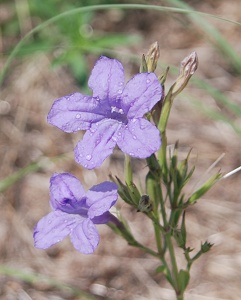 “Wild Petunia” is actually Ruellia nudiflora
“Wild Petunia” is actually Ruellia nudiflora
The near meadow had little clumps of Ruellia near the mowed maintenance path. Farther out in the near meadow, near the drainage across it, I found scattered green-antelope-horns milkweed in bloom, less than knee-high:
In dry years, this milkweed blooms only in spring, right after Antelope-horns, A. asperula (which blooms only in spring, period), but with summer rain it will pop up again, though buried in grass. In wet years, it may grow a foot higher. The only monarch larvae I’ve seen here are on this species. We see monarchs mostly spring and fall, on migration.
Our summer/fall milkweed, even in dry years, is Zizotes Milkweed, which one of the summer butterflies, the Queen, really seems to like.
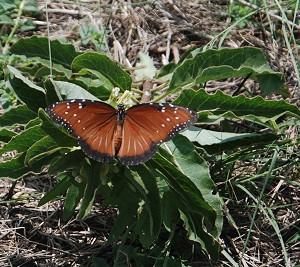 Asclepias oenotheroides with Queen butterfly ovipositing
Asclepias oenotheroides with Queen butterfly ovipositing
This is a small plant, always low to the ground, with flowers on the main stem, between the layers of leaves. The leaves are wavy-edged.
Queen butterflies–abundant from midsummer into fall here–are also attracted by Frogfruit (or Fogfruit), Phyla incisa, which flowers even in midsummer heat if there’s been rain:
In the main grass beyond the secondary drainage, I found several flowers that had obviously given up in the dry…and then could not resist trying again after the heavy rains.
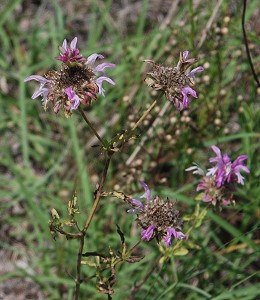 Lemon Horsemint, Monarda citriodora
Lemon Horsemint, Monarda citriodora
The Lemon Horsemint had finished its spring flowering in the dry, and the plants looked almost dead, but rain brought them back…a little.
Stiff-stem Prairie Flax, Linum rigidum–which is usually a spring-only bloomer–showed up again on the mowed trails.
Gaillardia, or Firewheel, is a drought-tolerant bloomer from late spring, but quits by mid-June if it’s dry, blooming through mid-to late July if it’s wet. Even in a dry year, it will flower again if there’s a big thunderstorm.
Most of the tallgrasses won’t display their flowers for another month, but Eastern Gama flowers earlier (to the delight of deer, which love the “popcorn” seeds.) It has an unusual and very beautiful floral display:
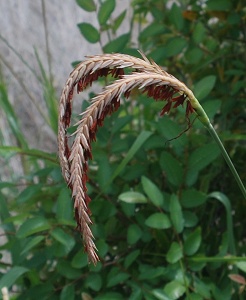 Eastern Gama, Tripsacum dactyloides
Eastern Gama, Tripsacum dactyloides
Here, this tallgrass grows only on damp sites and is rarely more than four feet tall even there, more often a little lower. It’s another of the natives we’ve restored to the place and it’s now spreading. (Behind it is a young cedar elm, Ulmus crassifolia.)
Midsummer rain also helped along the annual wild grape supply:
Wildlife start on the grapes before they’re even ripe, but in a good year some grapes will be on the vines for a couple of months. All are thick-skinned; some individual vines have better flavor (to humans) than others, but all are eaten by wildlife.
Roughleaf Dogwood berries are still green, but already they’re being taken by wildlife:
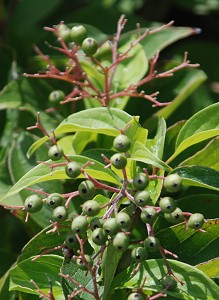 Roughleaf Dogwood, Cornus drummondii
Roughleaf Dogwood, Cornus drummondii
This shrub-to-small-tree is a common understory in riparian woods and a component of fencerows and edges; it’s disappearing with development because it’s not recognized as valuable, yet it’s a resource for the fall bird migration (and we start seeing songbird migrants in August.)
We start noticing the big black-and-yellow orb weavers in June, and they grow steadily bigger…in July, they’re the dominant large spider, with webs strung everywhere they can find a support.
This one’s web is over three feet in diameter. A spider this size can easily take a big dragonfly (I’ve seen one with a Common Green Darner.) Right after a thunderstorm, you can find the spider hiding under leaves or the undersides of branches it’s used for support, but soon they’re back out on the web, ready for prey.
Also responding to sudden heavy rain–some of the seedling oaks we’ve planted.
After a couple of weeks, the young red oak (from a local tree’s acorn) had put out new leaves and lengthened twigs, the “spring green” contrasting with the other, older leaves’ dark green.
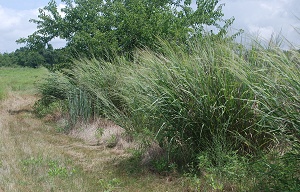
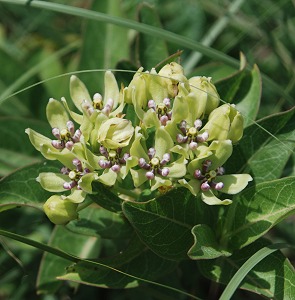
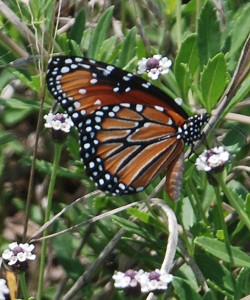
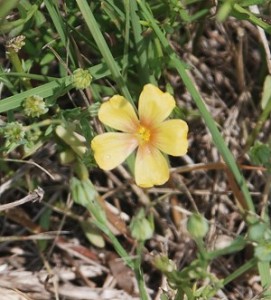
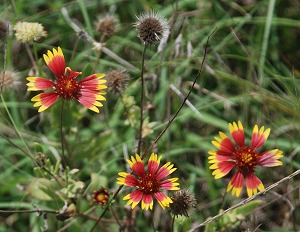
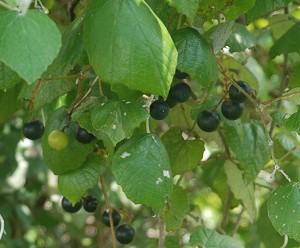
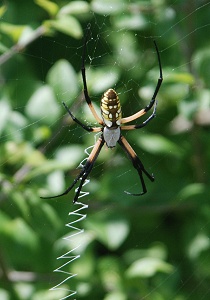
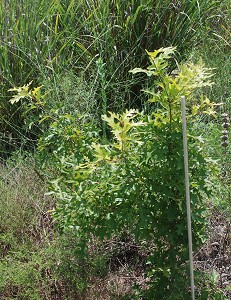
Comment by Abigail Miller — July 31, 2010 @ 9:44 am
My “worker-guys” (a couple of my tenants who do some of the heavier clearing and mowing for me on weekends) were completely fascinated by a couple of huge orb-weavers last week. They had big strong grasshoppers caught in their nets.
I have always called them “garden spiders.” Don’t know where I got that name from. Orb-weaver is their “right” name? I know, right names in English are kind of debatable sometimes.
Anything that eats grasshoppers ought to be getting fat. Do roadrunners? My roadrunner population seems healthy.
Comment by Steve Willson — July 31, 2010 @ 10:27 am
It’s interesting to read your posts and see your western species looking so similar to the eastern species found here. We share a lot of the same genera, but not many of the same species.
Asclepias viridis is one we share. I understand that A. asperula has a similar appearance. The Queen butterfly doesn’t occur in Ohio. It really has some neat coloration.
Comment by elizabeth — July 31, 2010 @ 10:40 am
Steve, A. asperula tends to lie flat (stems stretch out from base, not up) with narrower leaves spaced farther apart, and the flowering heads are tighter–to me they look much like popcorn balls. The green “hoods” you see on A. viridis, clearly visible between the flowers, do not show at all on A. asperula. The flower clusters may be almost flat on the ground.
When the Queen is perched with wings folded over the back (the second shot) people have mistaken it for a monarch, but it’s smaller, the hind wing is never as pale, and the abdomen is a different color. It’s a lovely butterfly and I’m always delighted when they reappear. Bet you have summer monarchs, though. We almost never see a monarch from June to September.
Comment by elizabeth — July 31, 2010 @ 10:49 am
Abigail: these spiders have a lot of common names, including “garden spider” (though some other spiders are also known as garden spider) but they fall into the “orb-weaver” group of spiders because of the shape of their web. I’m no expert on spiders–I just photograph them and look them up to find out what they are–but these big guys are fun to watch starting a web, if you ever get the chance.
Grasshopper-eaters include young foxes. The year we had the most rapport with a gray fox vixen, she would let us watch (from a distance) her cubs learning to hunt by hunting grasshoppers. Their stalk-and-pounce technique improved, but at first when they did that high leap-pounce thing they’d fall over when they landed. I’ll bet young coyotes hunt them too, and a grown coyote would probably snatch one now and then. And yes, roadrunners eat them. So do wasps (well–they kill them and lay eggs in them and their larvae eat them, same thing), big spiders, robber flies, the smaller raptors (kites, kestrels), some other birds, etc.
Comment by Steve Willson — July 31, 2010 @ 9:11 pm
Thanks for the description of A. asperula.
You’re right about the Monarchs. We have them everywhere now. I probably saw 40 of them today.
Comment by Abigail Miller — August 1, 2010 @ 1:26 am
I’ve never seen young foxes, though I know they have raised families around here somewhere. But one of the funniest sights I have seen was of similar (lack of) grace displayed by young black vultures. I guess it’s a lot easier to take off and fly than it is to land. Picture a bird with a wingspan over two feet, landing on a smallish branch and then wildly swaying and contorting like an off-balance gymnast on the beam.
Comment by Margaret Middleton — August 1, 2010 @ 7:21 am
Are those wild grapes of yours a Muscadine variety or cousin? The thick skin you mentioned is typical of those, in my experience.
Comment by Chuck — August 1, 2010 @ 2:23 pm
The grapes in the picture look like the ones they called “mustang grapes” when I was a kid in Parker County (west of Fort Worth so quite a bit north of Elizabeth). My Mississippi-raised parents called them “muscadines”at first–since that’s what they looked like–until the neighbors told them the local name. The mustang grapes on our place were not good for eating, although my mother made jelly (one time) from the juice. She was allergic to the skins, however, and we left them for the wildlife after that.
Comment by elizabeth — August 1, 2010 @ 4:36 pm
We call them mustang grapes–though this is not the only species. The ones most people call mustang grapes have the leaves that are pointed at one side but mostly roundish.
Yeah, some people are really irritated by the juice. I think (IIRC) that it’s actually little crystals in the juice, precipitates, that you have to filter out (and it’s why it takes so blinkin’ long to get your mustang grape juice clear!) and those little crystals a) can give you tiny scratches and b) irritate where they cut. But the jelly is great. It’s just a lot of work. My last batch, years ago, I got the worst case of chiggers ever while picking grapes, and then the filtration process was…lengthy.
Oddly, I’ve eaten these up here with no problems, though usually only one or two at a time. The grapes on the nearest vine aren’t as tasty as those from the north fenceline.
Comment by elizabeth — August 1, 2010 @ 4:44 pm
Abigail: Young critters are often funny–I’ve seen much smaller young birds trying to learn how to land, but I’ll bet the vultures were funnier. In San Antonio, I watched two young squirrels try to follow their mother along a power line drop to our house–the gyrations they went through to stay on the line were so funny. I wonder what we do that’s as funny to them.
Comment by Kip Colegrove — August 8, 2010 @ 7:40 pm
The big spiders that weave orb webs with zigzags in the middle are argiopes. They can handle really large prey. I once watched one make short work of a very large moth.
Comment by Kip Colegrove — August 17, 2010 @ 9:07 am
Spiders of the genus Nephila are also huge, catch large prey, and sometimes make zigzags in their webs.
I used to live in Virginia, which is good country for people interested in spiders, though I’ve never had that much to do with the really big species.
Comment by Martin LaBar — October 6, 2010 @ 12:34 pm
Those Green Antelope Horns milkweed flowers are beautiful.